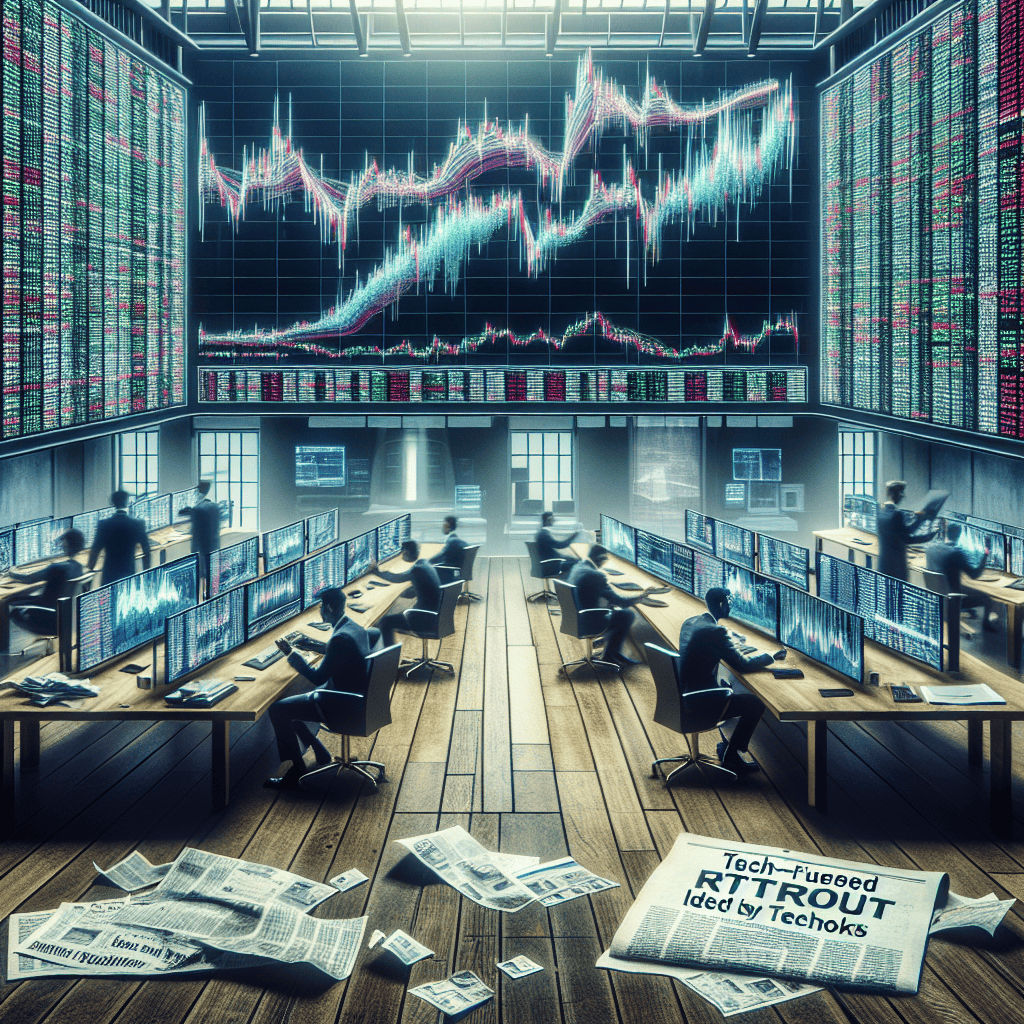“Steady Futures: Navigating the Calm After Tech Turbulence”
Introduction
US stock futures remained stable following a significant downturn driven by a sell-off in technology stocks. This market movement comes after a period of heightened volatility, where tech giants faced substantial pressure, leading to a broader market decline. Investors are closely monitoring economic indicators and corporate earnings reports to gauge the market’s direction. The steadiness in futures suggests a cautious optimism among traders, as they assess the potential for recovery amidst ongoing economic challenges and geopolitical uncertainties. This pause in volatility provides a moment for market participants to recalibrate their strategies in anticipation of future developments.
Impact Of Tech Sector Volatility On US Stock Futures
The recent fluctuations in the technology sector have had a pronounced impact on US stock futures, reflecting the broader market’s sensitivity to tech-driven dynamics. As the tech sector has become a cornerstone of the modern economy, its volatility inevitably reverberates through the financial markets. This phenomenon was particularly evident following a tech-fueled rout that left investors grappling with uncertainty. Despite the turbulence, US stock futures have shown a degree of steadiness, suggesting a complex interplay of factors at work.
To understand the impact of tech sector volatility on US stock futures, it is essential to consider the sector’s outsized influence on market indices. Technology companies, with their substantial market capitalizations, often drive significant movements in indices such as the S&P 500 and the Nasdaq Composite. Consequently, any substantial shifts in tech stock valuations can lead to pronounced changes in these indices, thereby affecting stock futures. The recent rout, characterized by sharp declines in major tech stocks, underscored this relationship, as futures initially reacted with heightened volatility.
However, the steadiness observed in US stock futures following the initial turmoil suggests that investors are weighing a multitude of factors beyond immediate tech sector performance. One possible explanation is the broader economic context, which includes considerations such as interest rates, inflation, and geopolitical developments. These elements can either exacerbate or mitigate the impact of tech sector volatility, depending on their alignment with market expectations. For instance, if investors anticipate that central banks will maintain accommodative monetary policies, this could provide a cushion against tech-driven market swings.
Moreover, the resilience of US stock futures may also be attributed to the diversification strategies employed by investors. While technology stocks have been a significant driver of market gains in recent years, savvy investors often balance their portfolios with assets from other sectors. This diversification can help absorb shocks from any single sector, including technology, thereby contributing to the overall stability of stock futures. Additionally, the presence of institutional investors, who typically adopt long-term investment horizons, can further stabilize futures markets by providing a counterbalance to short-term volatility.
Another factor contributing to the steadiness of US stock futures is the role of market sentiment and investor psychology. Following a period of heightened volatility, market participants often reassess their positions and strategies, leading to a more measured approach to trading. This recalibration can result in a stabilization of futures as investors seek to navigate the complexities of the market environment. Furthermore, the availability of real-time data and advanced analytical tools enables investors to make more informed decisions, potentially reducing the likelihood of knee-jerk reactions to market fluctuations.
In conclusion, while the tech sector’s volatility has undeniably influenced US stock futures, the observed steadiness in the aftermath of a tech-fueled rout highlights the multifaceted nature of financial markets. Factors such as economic conditions, diversification strategies, and investor sentiment all play crucial roles in shaping the response of stock futures to sector-specific developments. As the market continues to evolve, understanding these dynamics will be essential for investors seeking to navigate the challenges and opportunities presented by the ever-changing landscape of the financial markets.
Analyzing The Stability Of US Stock Futures Post-Tech Rout
In the wake of a significant downturn driven by the technology sector, US stock futures have shown a remarkable steadiness, suggesting a potential stabilization in the market. This development comes after a period of heightened volatility, where tech stocks, which have been the darlings of the market for an extended period, experienced a sharp sell-off. The recent rout in the technology sector was primarily fueled by concerns over high valuations, regulatory pressures, and a shift in investor sentiment towards more traditional sectors. As investors reassess their portfolios, the steadiness in stock futures indicates a cautious optimism about the broader market’s resilience.
The technology sector has been a significant driver of market gains over the past decade, with companies like Apple, Amazon, and Microsoft leading the charge. However, the recent sell-off has highlighted the vulnerabilities inherent in sectors that experience rapid growth. Despite these challenges, the steadiness in US stock futures suggests that investors are beginning to look beyond the immediate turmoil. This stability can be attributed to several factors, including strong corporate earnings reports from non-tech sectors, which have provided a buffer against the tech-driven volatility.
Moreover, the Federal Reserve’s monetary policy stance continues to play a crucial role in shaping market expectations. With interest rates remaining relatively low, there is an underlying support for equities, as investors seek higher returns than those offered by fixed-income securities. This environment has encouraged a rotation into sectors that are perceived as undervalued or poised for recovery, such as financials and industrials. Consequently, the broader market has shown resilience, even as tech stocks face headwinds.
In addition to domestic factors, global economic conditions are also influencing US stock futures. The ongoing recovery from the pandemic-induced recession has been uneven across different regions, but there are signs of improvement in key markets. For instance, the European and Asian economies have shown signs of stabilization, which bodes well for multinational companies with significant international exposure. This global perspective provides a more balanced view of the market, mitigating some of the concerns surrounding the tech sector’s performance.
Furthermore, investor sentiment is gradually shifting towards a more balanced approach, with a focus on diversification and risk management. The recent tech rout has served as a reminder of the importance of maintaining a diversified portfolio, prompting investors to reassess their strategies. This shift is reflected in the steadiness of US stock futures, as market participants seek to navigate the current landscape with a more cautious and measured approach.
In conclusion, while the recent tech-fueled rout has undoubtedly shaken investor confidence, the steadiness in US stock futures suggests a potential stabilization in the market. The resilience of non-tech sectors, supportive monetary policy, and improving global economic conditions all contribute to this stability. As investors continue to adapt to the evolving market dynamics, the focus on diversification and risk management will likely play a pivotal role in shaping future market trends. Ultimately, the steadiness in stock futures serves as a testament to the market’s ability to weather short-term disruptions and adapt to changing conditions, providing a foundation for potential recovery and growth.
Key Factors Influencing US Stock Futures Amid Market Fluctuations
In the wake of a tech-fueled rout that sent ripples through the financial markets, US stock futures have shown signs of steadiness, offering a momentary reprieve for investors. This stabilization comes after a period of heightened volatility, primarily driven by the performance of major technology stocks. As market participants seek to understand the underlying factors influencing these fluctuations, several key elements emerge as pivotal in shaping the current landscape of US stock futures.
Firstly, the role of macroeconomic indicators cannot be overstated. Economic data releases, such as employment figures, inflation rates, and GDP growth, play a crucial role in shaping investor sentiment. Recently, mixed signals from these indicators have contributed to market uncertainty. For instance, while some reports suggest a robust labor market, others indicate potential inflationary pressures, leading to speculation about the Federal Reserve’s future monetary policy actions. Consequently, investors remain vigilant, closely monitoring these indicators for any signs that could influence the central bank’s decisions on interest rates.
In addition to macroeconomic factors, corporate earnings reports have also been instrumental in driving market movements. The technology sector, in particular, has been under intense scrutiny, with investors keenly analyzing quarterly results to gauge the health and growth prospects of major tech companies. Recent earnings reports have painted a mixed picture, with some firms exceeding expectations while others have fallen short. This divergence in performance has contributed to the volatility observed in the stock market, as investors reassess their positions based on the latest financial disclosures.
Moreover, geopolitical developments continue to exert influence over market dynamics. Trade tensions, international conflicts, and diplomatic negotiations all have the potential to impact investor confidence and, by extension, stock futures. For example, ongoing trade negotiations between the United States and its key trading partners have introduced an element of uncertainty, as market participants weigh the potential outcomes and their implications for global supply chains and economic growth. Similarly, geopolitical tensions in various regions can lead to fluctuations in commodity prices, further affecting market sentiment.
Another factor that has garnered attention is the evolving landscape of regulatory policies. As governments around the world grapple with issues such as data privacy, antitrust concerns, and digital taxation, technology companies find themselves at the forefront of regulatory scrutiny. The outcomes of these regulatory debates can have significant implications for the profitability and operational strategies of tech firms, thereby influencing their stock performance and, consequently, the broader market.
Furthermore, investor behavior and sentiment play a critical role in shaping market trends. In times of uncertainty, market participants often exhibit heightened sensitivity to news and events, leading to increased volatility. The recent tech-fueled rout serves as a reminder of how quickly sentiment can shift, prompting investors to adopt a cautious approach. As a result, many are diversifying their portfolios, seeking refuge in sectors perceived as more stable or resilient to market fluctuations.
In conclusion, the steadiness observed in US stock futures following a tech-driven downturn can be attributed to a confluence of factors. Macroeconomic indicators, corporate earnings, geopolitical developments, regulatory policies, and investor sentiment all intertwine to create a complex and dynamic market environment. As investors navigate these challenges, a keen understanding of these key factors will be essential in making informed decisions and anticipating future market movements.
Investor Sentiment And Its Effect On US Stock Futures Stability

Investor sentiment plays a crucial role in the stability of US stock futures, particularly in the wake of significant market events such as a tech-fueled rout. When investors react to market fluctuations, their collective behavior can either stabilize or destabilize stock futures. Understanding the dynamics of investor sentiment is essential for comprehending how stock futures maintain steadiness after a period of volatility.
In the aftermath of a tech-fueled rout, investor sentiment often becomes a focal point for market analysts. The technology sector, known for its rapid growth and innovation, can experience sharp corrections that ripple through the broader market. Such corrections can lead to heightened uncertainty among investors, prompting them to reassess their portfolios and risk tolerance. However, despite the initial shock, stock futures can exhibit steadiness as investors gradually regain confidence.
One factor contributing to the stability of stock futures is the role of institutional investors. These entities, which include mutual funds, pension funds, and hedge funds, often have a long-term investment horizon. Their strategic approach to investing allows them to weather short-term market fluctuations without making hasty decisions. As a result, their presence in the market can provide a stabilizing effect, as they are less likely to engage in panic selling during periods of volatility.
Moreover, the Federal Reserve’s monetary policy can also influence investor sentiment and, consequently, the stability of stock futures. In times of market turbulence, the Fed may implement measures such as interest rate adjustments or quantitative easing to support economic growth and maintain financial stability. These actions can reassure investors, fostering a sense of confidence that helps stabilize stock futures.
Additionally, the dissemination of information plays a pivotal role in shaping investor sentiment. In today’s digital age, news and data are rapidly accessible, allowing investors to make informed decisions. However, the speed at which information spreads can also lead to overreactions, as investors may respond to headlines without fully understanding the underlying factors. To mitigate this, market participants often rely on expert analysis and insights to navigate the complexities of the market, which can contribute to a more measured response and, ultimately, the steadiness of stock futures.
Furthermore, diversification strategies employed by investors can enhance the stability of stock futures. By spreading investments across various sectors and asset classes, investors can reduce their exposure to sector-specific risks, such as those associated with the technology industry. This approach not only mitigates potential losses but also promotes a balanced market environment, where the impact of a single sector’s volatility is less pronounced.
In conclusion, the steadiness of US stock futures following a tech-fueled rout is influenced by a combination of factors, including the behavior of institutional investors, the Federal Reserve’s monetary policy, the dissemination of information, and diversification strategies. While investor sentiment can be volatile in the short term, these elements work together to foster a more stable market environment. As investors navigate the complexities of the financial landscape, understanding the interplay between sentiment and market stability remains essential for making informed investment decisions. Through careful analysis and strategic planning, investors can contribute to the resilience of stock futures, ensuring that they remain steady even in the face of significant market events.
Comparing US Stock Futures Performance Before And After Tech Sell-Off
In the wake of a significant tech-fueled sell-off, US stock futures have shown a remarkable steadiness, offering a moment of respite for investors and market analysts alike. This stability comes after a period of heightened volatility, primarily driven by the sharp decline in technology stocks, which have been the backbone of market growth in recent years. To understand the current performance of US stock futures, it is essential to compare their behavior before and after the recent tech sell-off, providing insights into the broader market dynamics at play.
Before the sell-off, US stock futures were riding high on a wave of optimism, buoyed by strong earnings reports from major tech companies and a general sense of economic recovery. The technology sector, in particular, had been a significant driver of this upward momentum, with investors placing substantial bets on the continued growth and innovation within this space. The anticipation of new product launches, coupled with robust consumer demand, had created an environment where tech stocks were seen as a safe haven for capital, leading to elevated valuations and increased market participation.
However, the landscape shifted dramatically as concerns over rising interest rates and regulatory pressures began to weigh heavily on the tech sector. The sell-off was triggered by a combination of factors, including fears of tighter monetary policy from the Federal Reserve and increased scrutiny from regulators, both domestically and internationally. These concerns led to a reevaluation of the high valuations that tech stocks had commanded, resulting in a swift and pronounced market correction.
In the aftermath of this sell-off, US stock futures have exhibited a notable steadiness, suggesting that investors are beginning to recalibrate their strategies and expectations. This newfound stability can be attributed to several factors. Firstly, there is a growing recognition that while the tech sector may face headwinds, the broader economy remains on a solid footing. Economic indicators, such as employment figures and consumer spending, continue to paint a picture of resilience, providing a foundation for market confidence.
Moreover, the diversification of investment portfolios has played a crucial role in stabilizing stock futures. As investors reassess their exposure to the tech sector, there has been a noticeable shift towards other industries that are perceived as less vulnerable to interest rate hikes and regulatory changes. Sectors such as healthcare, consumer staples, and financials have garnered increased attention, offering alternative avenues for growth and income.
Additionally, the role of institutional investors cannot be overlooked in this context. These market participants, with their vast resources and sophisticated strategies, have been instrumental in providing liquidity and support during periods of volatility. Their ability to navigate complex market environments has helped to mitigate the impact of the tech sell-off, contributing to the overall steadiness observed in stock futures.
In conclusion, the comparison of US stock futures performance before and after the tech sell-off reveals a market in transition. While the initial shock of the sell-off created turbulence, the subsequent stabilization of stock futures indicates a more measured and diversified approach by investors. As the market continues to adapt to evolving economic conditions and regulatory landscapes, the resilience of US stock futures serves as a testament to the underlying strength and adaptability of the financial markets. This period of steadiness, following a tech-fueled rout, underscores the importance of diversification and strategic foresight in navigating the complexities of today’s investment landscape.
Strategies For Navigating US Stock Futures In A Volatile Market
In the wake of a tech-fueled rout that has left investors on edge, US stock futures have shown signs of steadiness, offering a momentary reprieve in an otherwise volatile market environment. Navigating such fluctuations requires a strategic approach, as market participants seek to balance risk and opportunity. Understanding the underlying factors that contribute to market volatility is crucial for developing effective strategies. The recent turbulence in the tech sector, driven by a combination of regulatory pressures, earnings reports, and macroeconomic concerns, has underscored the importance of staying informed and adaptable.
One key strategy for navigating US stock futures in a volatile market is diversification. By spreading investments across various sectors and asset classes, investors can mitigate the impact of sector-specific downturns. This approach not only reduces risk but also positions investors to capitalize on potential gains in other areas of the market. For instance, while tech stocks may experience a downturn, sectors such as healthcare or consumer staples might offer more stability and growth potential. Thus, a well-diversified portfolio can serve as a buffer against market volatility.
In addition to diversification, maintaining a long-term perspective is essential. Market volatility often triggers emotional responses, leading investors to make impulsive decisions that can be detrimental to their financial goals. By focusing on long-term objectives and maintaining a disciplined investment approach, investors can avoid the pitfalls of short-term market fluctuations. This involves setting clear investment goals, understanding one’s risk tolerance, and adhering to a well-defined investment plan. Such discipline can help investors remain focused on their long-term strategy, even amid market turbulence.
Moreover, staying informed about market trends and economic indicators is vital for making informed investment decisions. Regularly reviewing financial news, analyst reports, and economic data can provide valuable insights into market dynamics and potential future movements. This information can help investors identify emerging opportunities and adjust their strategies accordingly. For example, understanding the implications of interest rate changes or geopolitical developments can enable investors to anticipate market shifts and position their portfolios to benefit from these changes.
Another effective strategy is the use of hedging techniques to protect against downside risk. Options and futures contracts can serve as valuable tools for managing risk in a volatile market. By employing these instruments, investors can establish positions that offset potential losses in their portfolios. While hedging can be complex and may not be suitable for all investors, it offers a way to safeguard investments during periods of heightened uncertainty.
Finally, consulting with financial advisors or investment professionals can provide additional guidance and expertise. These professionals can offer personalized advice based on an individual’s financial situation and investment goals. They can also help investors navigate complex market conditions and develop strategies tailored to their specific needs. By leveraging the knowledge and experience of financial experts, investors can enhance their ability to make informed decisions and achieve their financial objectives.
In conclusion, while US stock futures may exhibit steadiness following a tech-fueled rout, the inherent volatility of the market necessitates a strategic approach. Through diversification, maintaining a long-term perspective, staying informed, employing hedging techniques, and seeking professional advice, investors can effectively navigate the challenges of a volatile market. By adopting these strategies, they can position themselves to manage risk and seize opportunities, ultimately enhancing their potential for success in the ever-changing landscape of US stock futures.
The Role Of Economic Indicators In Stabilizing US Stock Futures
In the wake of a tech-fueled rout that sent shockwaves through the financial markets, US stock futures have shown signs of stabilization. This development underscores the critical role that economic indicators play in providing a semblance of stability amid market volatility. As investors navigate the complexities of the financial landscape, these indicators serve as vital tools for assessing the health and direction of the economy, thereby influencing market sentiment and decision-making.
Economic indicators, such as employment data, inflation rates, and gross domestic product (GDP) growth, offer valuable insights into the underlying economic conditions. For instance, robust employment figures can signal a healthy economy, boosting investor confidence and potentially leading to a rise in stock futures. Conversely, disappointing employment data may trigger concerns about economic slowdown, prompting a more cautious approach from investors. In this context, the recent stabilization of US stock futures can be partially attributed to favorable economic indicators that have helped to assuage fears of a prolonged downturn.
Moreover, inflation rates play a pivotal role in shaping market expectations and influencing stock futures. When inflation is perceived to be under control, it can create an environment conducive to investment, as stable prices enhance purchasing power and consumer confidence. On the other hand, rising inflation can lead to increased costs for businesses and consumers alike, potentially dampening economic growth and exerting downward pressure on stock futures. Therefore, monitoring inflation trends is essential for investors seeking to anticipate market movements and adjust their strategies accordingly.
In addition to employment and inflation data, GDP growth is another crucial economic indicator that impacts stock futures. A strong GDP growth rate is often indicative of a thriving economy, which can bolster investor sentiment and drive stock prices higher. Conversely, sluggish GDP growth may raise concerns about economic stagnation, leading to a more cautious outlook for stock futures. As such, the recent steadiness in US stock futures can be seen as a reflection of positive GDP growth figures that have helped to counterbalance the effects of the tech-driven market turbulence.
Furthermore, central bank policies, particularly those of the Federal Reserve, are closely watched by investors as they can significantly influence economic indicators and, by extension, stock futures. Interest rate decisions, for example, have a direct impact on borrowing costs and consumer spending, thereby affecting economic growth and market dynamics. A dovish stance by the Federal Reserve, characterized by lower interest rates, can stimulate economic activity and support stock futures. Conversely, a hawkish approach, with higher interest rates, may cool down an overheating economy but also pose challenges for stock market performance.
In conclusion, the stabilization of US stock futures following a tech-fueled rout highlights the indispensable role of economic indicators in guiding investor sentiment and market behavior. By providing a comprehensive picture of the economic landscape, these indicators enable investors to make informed decisions and navigate the complexities of the financial markets. As the global economy continues to evolve, the importance of closely monitoring economic indicators cannot be overstated, as they remain key determinants of market stability and future growth prospects.
Q&A
1. **What caused the recent tech-fueled rout in US stock markets?**
– The rout was primarily driven by a sell-off in major technology stocks, which faced pressure due to rising bond yields and concerns over valuations.
2. **How did US stock futures react following the tech-fueled rout?**
– US stock futures remained steady, indicating a pause or stabilization after the significant declines in tech stocks.
3. **Which major technology stocks were most affected by the rout?**
– Major technology stocks such as Apple, Amazon, and Microsoft were among those most affected by the sell-off.
4. **What role did bond yields play in the tech stock sell-off?**
– Rising bond yields made equities, particularly high-valuation tech stocks, less attractive, leading to increased selling pressure.
5. **How did investors respond to the tech stock sell-off in terms of market strategy?**
– Investors shifted their focus towards more defensive sectors and value stocks, seeking stability amid the volatility in tech stocks.
6. **What are the broader market implications of the tech-fueled rout?**
– The rout raised concerns about the sustainability of high valuations in the tech sector and prompted a reassessment of risk across the broader market.
7. **What are analysts predicting for the near-term future of US stock markets following the rout?**
– Analysts are divided, with some predicting continued volatility and others expecting a potential rebound as investors adjust to new market conditions.
Conclusion
US stock futures remained stable following a significant downturn driven by a sell-off in technology stocks. This stability suggests that investors are cautiously assessing the market conditions after the tech sector’s volatility. The steadiness in futures indicates a potential pause or consolidation phase as market participants digest recent movements and evaluate future economic indicators and earnings reports. Overall, the market appears to be in a wait-and-see mode, balancing between concerns over tech valuations and broader economic recovery prospects.





